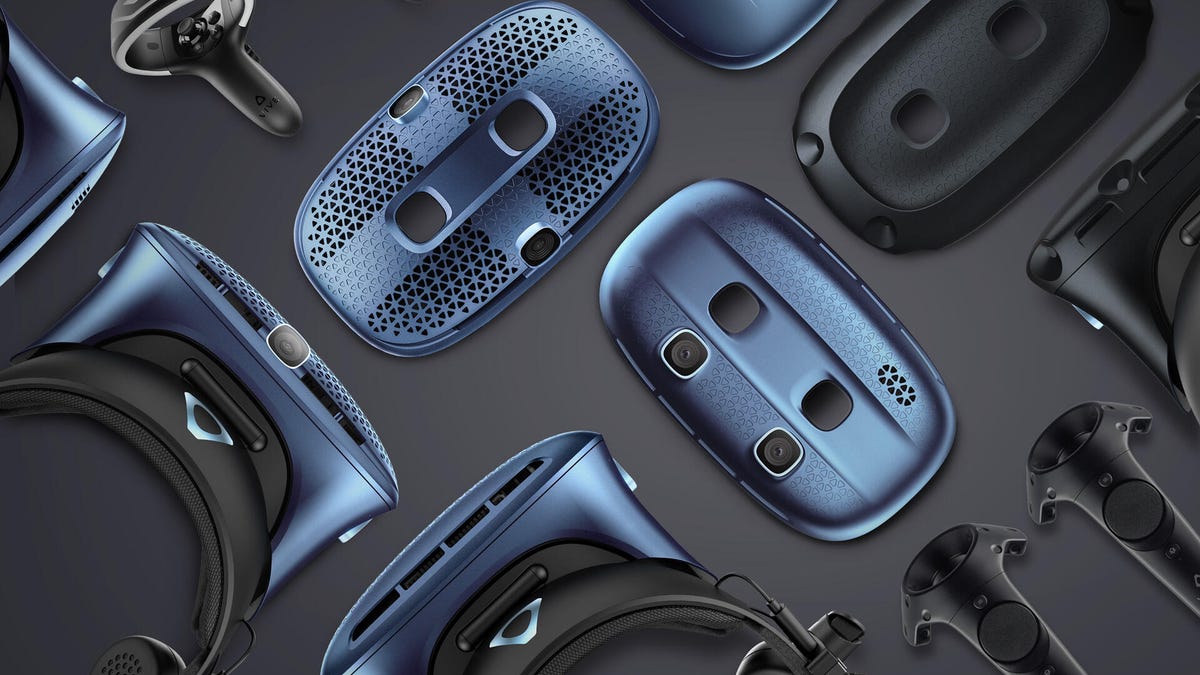HTC Vive Cosmos XR blends AR and VR using a snap-on faceplate
The Vive's VR future is in modular parts. Plus, a peek at "Project Proton."

The Vive Cosmos and its various faceplates. Modular VR... like it or hate it.
HTC and its Vive headsets have walked a strange middle ground in VR: not quite affordable mainstream, not fully enterprise, and still part of the SteamVR ecosystem alongside its competitor, the Valve Index. The Vive Cosmos, originally announced at CES 2019, continues that path, but is also taking things in a new direction. The Taiwanese company will make swappable faceplates for the Cosmos -- its first major VR hardware since the original Vive in 2016 -- letting you instantly add extra features.
Those extra features mainly have to do with how many cameras are in each snap-on plate. An external-tracking faceplate, for example, gives the Cosmos flexibility to track movement with either its own built-in headset cameras, with external lighthouse boxes like the original Vive uses, or the Valve Index Base Stations. The added external-tracking faceplate costs $199, or comes in a bundle with the Cosmos for $899, available this quarter.
There are also plans for an XR-enabled Vive Cosmos that will add mixed reality through improved pass-through cameras that capture the outside world and blend it into VR, similar in theory to what I experienced with a far more expensive headset made by Varjo. This "Cosmos XR" edition of HTC's VR headset won't be sold as an add-on yet, and will instead come as a developer-targeted bundle, indicating that a mainstream launch could still be farther off.
That's a lot of variations. But HTC is also launching a more affordable version of the Cosmos, called the Vive Cosmos Play, that will have only four tracking cameras on the front instead of the six on the current Cosmos. HTC calls it ideal for everyday gaming , but it will also have more limited vertical tracking.
HTC's new CEO, Yves Maitre, sees a big role for 5G, too, much like every other player in the VR/AR landscape at the moment. Some of that benefit will come from remote rendering over 5G networks that will skip needing a nearby PC to plug into, but how Vive will work with 5G hasn't been fully laid out yet.
For now, though, the Cosmos still connects to a PC, so it isn't a standalone VR headset like Facebook's Oculus Quest. And it doesn't plug into a phone, like Qualcomm's promised next wave of headsets and lightweight VR viewers. The Vive Cosmos is also more expensive than some other PC-connected headsets like the Oculus Rift S, but the faceplate tracking and mixed-reality add-ons should make it more flexible.
If that's not enough VR variations, HTC has also teased a totally new mixed-reality headset concept called Project Proton. It's a slimmer, more glasses-like variation on the Vive that will either be a standalone headset, a phone-tethered headset or both.
HTC's Project Proton glasses concept, in phone-tethered form.
The Proton looks like HTC's eventual version of the types of standalone/phone 5G-capable XR headsets that Qualcomm has been promising recently, and HTC isn't talking about it much more at the moment. The Proton, according to HTC's Maitre, is part of Vive's goal to evolve to a headset more like a pair of glasses. That's a common dream in AR/VR right now, shared by Facebook, Magic Leap and many others.
My concern is the meantime is that the last thing an already cluttered VR landscape needs is lots of modular extras. It's what turned me off, initially, about the Vive Tracker. But for anyone looking for ways to extend the ways that VR and AR can flex out, being expandable has more benefits than something closed-off. The road to where VR and AR are heading, compared to what we have now, is bound to be extremely messy. Maybe we'll need more than a few dongles and mods along the way.

